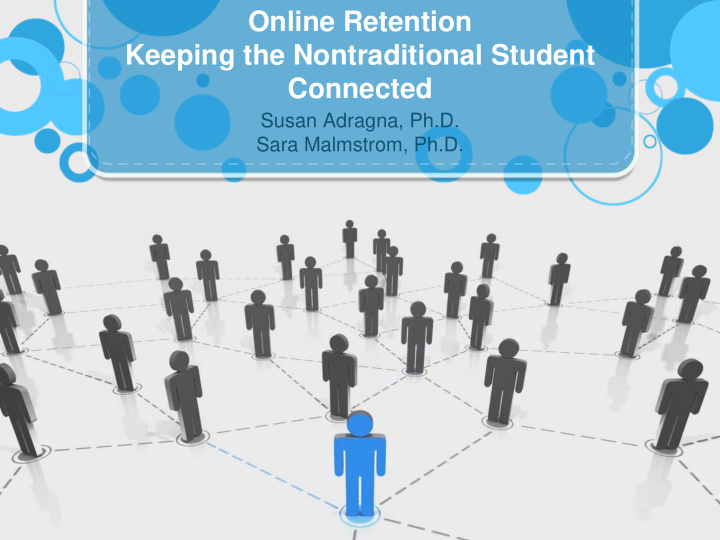



Online Retention Keeping the Nontraditional Student Connected Susan Adragna, Ph.D. Sara Malmstrom, Ph.D.
Session Overview • Who is the nontraditional student? • Why do they drop out? • Institutional Culture • Learning Community • Motivation • Support • Methodology • Action • Analysis & Results 2 Copyr i ght 2010
•73% Female •53% Black, Hispanic, or Multi-ethnic •Varied Professional Experiences •Returning/Retooling •Working •Families •Age 28+ 3 Copyr i ght 2010
Why Do They Drop Out? Health Existing Condition or New Health Issue Academic Time Management, Technology, Isolation Dismissal Loss of Job, Increased Work Responsibilities, Employment Change of Hours Natural Hurricanes, Earthquakes, Flooding Disaster Program Imposter Syndrome Rigor 4 Copyr i ght 2010
Institutional Culture The Culture of Retention Blame vs. Ownership Larger purpose, meaningful experience, being connected (Senge, 1990) Open Discourse (Bean, 2005) Flexibility and Creativity 5 Copyr i ght 2010
Learning Community Involvement as a predictor (Tinto, 2001) Attendance Shared learning (Tinto, 2001) Common venue Cohort Connected learning (Tinto, 2001) Common thread 6 Copyr i ght 2010
Motivation Building Bridges (Coley & Coley, 2010) Faculty-identify at-risk students, caring approach Staff-communication Students-perceptions Team, Value, Ownership Academic failure=stress=drop out 7 Copyr i ght 2010
Commitment Institutional Mission—Students first Resources Faculty High standards Communication Support Know your students Students Time Communication 8 Copyr i ght 2010
Support Academic Tutoring Resource Courses People Instructors Classmates Advisors Family 9 Copyr i ght 2010
Methodology Action Research Purpose: To inform and improve practice Goals Identify the Problem Plan of Action Implement the Plan Assess Effectiveness (Craig, 2009) 10 Copyr i ght 2010
Plan Data Sources Monthly Drop Reports Start Date Drop Date Admissions Counselor GPA 2.7 Reasons for Dropping 11 Copyr i ght 2010
Plan (cont.) Actions New Student Orientation (revised) Late Student Orientation Week 1 and 4 Student Calls Revised Week 1-Book Independent Advisor Meeting—Shift in Focus Repository for Resources APA Writing Resource Socialization 12 Copyr i ght 2010
Analysis and Results Analysis of Student Status Change Report 51% dismissal 18% financial reasons 1% health or family crisis 1% program too difficult 29% reason unknown/miscellaneous At-risk students 75% students with 2.7 GPA left first semester First semester drops were 58% of term drops, 40% second term, 25% third term 13 Copyr i ght 2010
Analysis and Results Treatments Late Student Enrollment—None dropped (previously not tracked) Week 1 and 4 Phone Calls-88% students reached Retention Meetings-LDA reduced by 28% (problem solving to proactive) 14 Copyr i ght 2010
were calculated. Analysis and Results (cont.) Persistence Data (Fall 2009 Baseline) Figure 1. Student drop trends by month. January+44%, February -33%, March +66%, April -55%, June no change 15 Copyr i ght 2010
Summary Early, continuous, intensive interventions (Seidman, 2005) 8 Interventions: Targeted at all students Student satisfaction: Phone calls, resource center (KUGSCAE), APA course Retention meetings: All on the same page 28% decrease on LDA report and 47% decrease in drops 16 Copyr i ght 2010
2010 ght i Copyr Questions? 17
References Bean, J. P. (2005). Nine themes of college student retention. In A. Seidman (Ed.). College student retention , pp. 215-241. Westport, CT: Praeger Publishers. Coley, C., & Coley, T. (2010). Retention and student success. Staying on track with early intervention strategies. Malvern, PA: SunGard Higher Education. Craig, D. V. (2009). Action research essentials. San Francisco, CA: Jossey-Bass Seidman, A. (2005). College student retention. Westport, CT: Praeger Publishers. Senge, P. M. (1990). The fifth discipline. Garden City, NY: Doubleday. Tinto, V. (2001). Rethinking the first year of college. Higher Education Monograph Series, Syracuse University. 18 Copyr i ght 2010
Recommend
More recommend